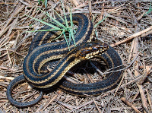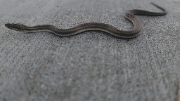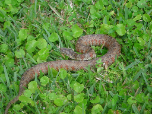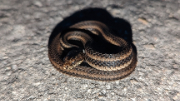Saltmarsh Snake (Nerodia clarkii)
Description: Salt marsh snakes grow to a total length (including tail) of 15–30 inches. They are also highly variable in both pattern and coloration. Found most commonly in salt marshes, this snake inhabits brackish and saltwater habitats; it is also found hiding in crab burrows. Though salt marsh snakes are common throughout the territory they inhabit, they have a tendency to be wary and secretive, so they are rarely seen. All members of this species reproduce via live birth, and all are semi-aquatic. Furthermore, all forms of this species may be distinguished as having either 21 or 23 rows of scales.
The seawater they inhabit exerts a continual draw on their tissue's electrolyte balance, due to osmosis. Its scaly reptilian skin acts as a barrier against external dehydration, but, if ingested, seawater draws the less-salty fluid from blood and tissues into the stomach. N. clarkii is the only species to establish itself in this saline niche, drinking only rainwater when it is available, and at other times swallowing nothing but prey animals with the same diluted body fluids as their own. All water species of snake (including N. clarkii) are typically considered to be non-venomous, though they do employ a complex series of enzymes in their saliva, resulting in some inflammation and edema to those who have been bitten
Habitat: This snake is most common in estuarine situations, such as coastal brackish and salt marshes containing Spartina, Juncus, Salicornia; it occurs in lesser abundance farther inland in freshwater marshes with arrowheads, sedges, and naiads. Toward the southern end of the range in Florida, it also inhabits buttonwood and red mangrove swamps and saline offshore islands. Microhabitats include the burrows of crayfish, fiddler crabs, or muskrats. Sometimes it can be found on shore under rocks, logs, and other cover.
Range: This species occurs in coastal areas on the southern United States and on the northern coast of Cuba. Its range includes brackish coastal habitats of the northern Gulf of Mexico, from the vicinity of Corpus Christi, Texas, eastward to Florida and including most of that state's coastline, including the Keys, then northward on the Atlantic coast to Volusia County; also the northern coast of Cuba.
Diet: Small fishes and invertebrates.
Reproduction: Ovovivparous. All members of this species reproduce via live birth. Mating season is in early spring, and it gives birth to live snakes (as opposed to laying eggs) in July and August. Young snakes are 7 to 9 inches long at birth.
Status: Listed as Least Concern in view of its wide distribution, presumed large population, and because it is unlikely to be declining fast enough to qualify for listing in a more threatened category.
»» Kingdom: Animalia - Animals
»» Phylum: Chordata - Chordates
»» Subphylum: Vertebrata - Vertebrates
»» Class: Reptilia - Reptiles
»» Order: Squamata - Scaled Reptiles
»» Suborder: Serpentes
»» Superfamily: Colubroidea
»» Family: Colubridae - Colubrids
»» Genus: Nerodia
»» Species: Nerodia clarkii - Saltmarsh Snake
This article uses material from the Wikipedia article "Nerodia clarkii", which is released under the Creative Commons Attribution-Share-Alike License 3.0. Content may have been omitted from the original, but no content has been changed or extended.
|







